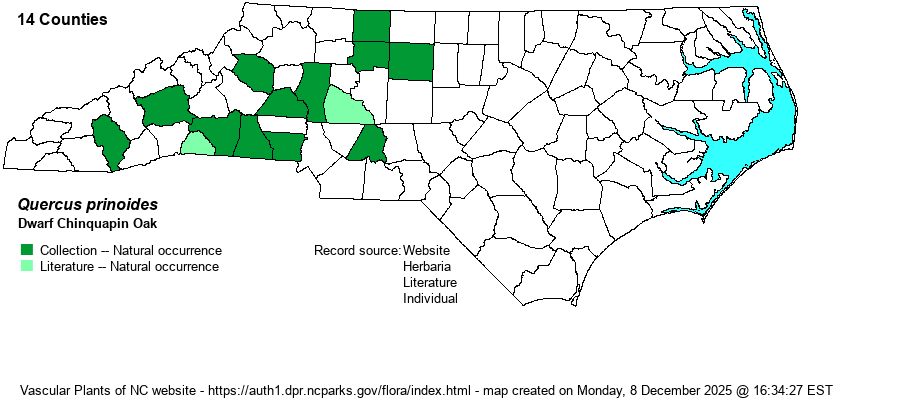| Author | Willdenow | |
| Distribution | Widely scattered in the central and western Piedmont, and in low elevations of the southern Mountains. Ranges (or ranged) east to Guilford and Stanly counties, and west to the foothills, plus records from Buncombe and Jackson counties in the Mountains. It is likely that a handful of these county collections are misidentified, but that is speculation, owing to so very few recent records known in the state. In fact, no one claims to have photographed this species on iNaturalist from NC.
This is primarily a Northern species of local and puzzling distribution. It ranges north to NH and NE, and south to central AL and OK. It appears to be very scarce in the Ohio Valley area, with most records from PA northward and OK to IA.
| |
| Abundance | Very rare, local, and strongly declining, in the Piedmont; and very rare and local in the southern Mountains. The strong declines are believed mainly to be due to fire suppression, rather than to habitat loss. As this is a clonal and shrubby species, it is assumed to be benefitted by fire, even though this is speculation in NC. This is one of the state’s rarest shrubs and is State Endangered, and it may be on the verge of extirpation. One editor (LeGrand) has seen it just once, a clonal colony with acorns along a wooded edge in Rowan County. | |
| Habitat | This species is scarce in much of its range. In NC, most records are from dry acidic slopes with openings or other early succession vegetation; the places may be rocky. It does occur in mesic sites as well, as long as partial or direct sunlight is available -– such as margins of dry or mesic woods. Some references suggest the species is found primarily over high pH soils (no doubt confounding this species with Q. muehlenbergii), but most records in VA (and probably in NC) seem to be over acidic soil; and recent references consider reports from high pH soils to be stunted or young Chinquapin Oak (Q. muehlenbergii). At any rate, suitable habitat seems abundant, unless the long absence of fire makes such places unsuitable for it. |
| Phenology | Flowers in April; fruits in August and September of the same year. | |
| Identification | This species is very poorly known in the state and might be easily overlooked. It is typically a clonal deciduous shrub, rarely a small tree, growing from 2-12 feet tall, mostly around 5-6 feet tall. The leaves are somewhat thick, and shiny above; they are rather small for an oak, usually about 4 inches long and about 2 inches wide, much smaller than on similar Chestnut Oak (Q. montana) and Chinquapin Oak. The leaf shape is elliptical to slightly obovate and heavily scalloped or lobed on the margins, like in the other two. Also, the other two species will not show acorns in summer or fall until the plants are perhaps 40-50 feet tall. Thus, identify the species by: 1) low stature with usually clonal habits; 2) dry or mesic edge or opening habitat in acidic soils (Chinquapin Oak grows only on high pH soil); 3) small leaves for an oak; and 4) presence of acorns in summer and fall. | |
| Taxonomic Comments | A few references had, or still have, this species lumped in with Chinquapin Oak, as a variety. When treated this way, the full species was usually named as Q. prinoides; Chinquapin Oak was named as Q. prinoides var. acuminata and Dwarf Chinquapin Oak as Q. prinoides var. prinoides. Thankfully, most references are more enlightened and treat both as good species.
| |
| Other Common Name(s) | Dwarf Chinkapin Oak, Dwarf Chestnut Oak, Scrub Chestnut Oak | |
| State Rank | S1 | |
| Global Rank | G5 | |
| State Status | E | |
| US Status | | |
| USACE-agcp | UPL link |
| USACE-emp | UPL link |

